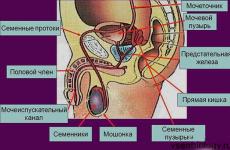Pushups. Seated press in a Smith machine: technique and execution options Shoulder exercises in a Smith machine
The exercise is considered one of the basic exercises for working on the muscles of the shoulder girdle. During movement, the front and medium beams deltoid muscles. When performing the exercise, you increase the strength and volume of your shoulders, and train endurance. Any of the variations of the barbell overhead press is an effective exercise if you follow the technique of its implementation.
Bench press
The overhead barbell press is a basic exercise for working the shoulder muscles, in particular the middle and anterior deltoids. There are several options for performing this exercise, the safest way is sitting on an incline bench in a Smith machine. In this article we will talk about the correct technique for performing a barbell press and the load on the target muscles. Pay close attention to the correct position of your hands and forearms to avoid injury.
Correct hand position on the bar:
When performing the exercise, you should choose a medium grip. With it, the forearms will be vertical to the floor at the bottom point of the movement. A narrow grip can prevent a technically correct version of performing a barbell press from behind the head due to the short amplitude of movement. And placing your hands too wide on the bar can harm your shoulder joints.
Equipment:
- In the exercise, use a barbell with a straight bar and a rack for it as a weight, respectively. Men use weights weighing 15-20 kg. It is preferable for girls to choose shells weighing 7-10 kg.
- It is important to take care of your shoes: slippery soles can lead to unpleasant consequences.
- Using an athletic belt will strengthen your lower back. And gloves will ensure a reliable grip of your hands on the bar.
- To perform a seated overhead press, you will need a bench.
- Grasp the bar. Place the sports equipment in the chest area. Depending on the option you choose to perform the exercise, you should sit on a bench or remain in a standing position.
- Take a breath. Push the barbell upward. Watch your posture. Hold the position for a second.
- Exhale and lower the bar behind your head. Stay in this position for a few seconds. Repeat the movement you have already mastered.
How much: 3 sets of 15 repetitions.
Exercise options
You should choose the appropriate way to perform the exercise based on your physical fitness. Professional athletes can perform the barbell overhead press while standing, while beginners are advised to do it while seated in the Smith.
Bench press while sitting on an incline bench
A safe option for performing the exercise. In case of back problems, it is better to use a sports bench with a variable inclination angle. If your back is healthy, perform overhead presses on a bench without supporting your back. Still, it is worth remembering the possible unwanted bilateral load on the spine.

Seated overhead press
Standing overhead press
This method will only be acceptable for experienced athletes. To perform the exercise in a standing position, use light weights.

Behind the head barbell press on the Smith machine
The safest way. Suitable for intermediate level athletes. The Smith machine sets the trajectory of your movement in a strictly defined plane, helping to avoid loss of balance.
Smith overhead press technique:
- Prepare the simulator. Lock the bar with the selected weight at the top point. Position the bench so that when sitting, the bar is behind your head. Place your feet on the floor. Extend your arms and grab the bar.
- Breathe in. With your elbows bent, stretch the bar to the level of the middle of your head. Press the bar up.

If you do not have the opportunity to exercise in this simulator, ask someone to back you up or use a barbell rack.
Performing an exercise in a Smith machine - video
website  2018-02-07
Technique for performing bench presses while sitting
2018-02-07
Technique for performing bench presses while sitting
Application of the exercise
To whom. Athletes of intermediate level and above. At the initial stage, replace the exercise with shoulder machines or similar dumbbell presses.
When. At the beginning of the shoulder workout. You can do the exercise both at a fast pace for pumping and for mass. Choose a training regimen individually for yourself (by trial and error).
How many. On average, the exercise is performed in 4 sets of 12-15 repetitions. Rest between sets for about 90 seconds.
What muscles work: load on a 10-point scale
Muscles involved
The overhead barbell press tightens the muscles in your shoulders and upper chest. The work also includes the trapezius and serratus anterior muscles, triceps, and forearms.
If you lower the bar to ear level, the tension will fall exclusively on the deltoid muscles. And when lowering the bar as far as possible, the top of the trapezius is involved in the work.
When lowered low, the exercise becomes more dangerous for the shoulder joints. Be careful when performing the full range of motion in the exercise!

- Watch your breathing. Exhale - lift the bar, and inhale - return to the previous position.
- Avoid sudden movements.
- Try to limit the range of motion.
- Perform the barbell press only by tensing the deltoid muscles.
- Keep your back straight. Maintain a natural arch in your lower back. Look exclusively forward.
- It is necessary to responsibly approach the issue of choosing weights to avoid undesirable consequences. Beginners use an empty bar to perform the exercise correctly. In other cases, the weight is chosen correctly if you can lift the weight a given number of times while observing the technique. If you still have the strength for additional repetitions, increase the weight.
- Take the time to warm up well before performing overhead presses. Then do a couple of warm-up presses with an empty bar. Only after this proceed to working approaches.
Indications and contraindications:
The barbell overhead press is included in various training programs for professional athletes. Regular training of the shoulder muscles is also necessary for sports fans involved in badminton, tennis, gymnastics or martial arts.
There is no need to perform the exercise if you have any pathology of the shoulder joints. Even with the correct technique, there is a risk of injury. In the position of the barbell behind the head, the position of the shoulder joints is unstable.
Which is better: bench press from behind your head or from your chest?
Most people prefer to do the standing barbell press from the chest. This is a more natural version of the exercise without the high risk of injury. In addition, in the barbell chest press the range of motion is much greater. Because of this, the exercise is considered more effective.
Alternative Exercises
In case of possible contraindications to performing the exercise due to health conditions, you can include the “Arnold Press” in your workout, which will help achieve a similar effect.

Many gyms have a Smith machine, but not all athletes work in this machine, considering exercises in it ineffective compared to exercises with free weights. Let's figure out how to properly do a seated bench press in a Smith machine, and what advantages this simulator has.
Smith machine
The design of the Smith simulator (or machine) allows you to perform exercises only with a limited amplitude. Amplitude regulators are special limiters. The essence of the work of the simulator is to provide the athlete with stability of the weight when performing a particular exercise. These same limiters perform a safety role - they replace the second person, who, as a rule, monitors your safety during the training process.
Video: Smith machine design and functionality
The main purpose of such a simulator is to perform bench presses in a sitting, lying or standing position, squats and other exercises. The Smith machine allows you to strengthen large muscles and entire muscle groups.
Smith machine barbell press variations
Your position on the Smith machine affects which muscles will be worked during the exercise.
Seated press (classic version) – we work the shoulders and chest muscles
This type of press allows you to work your shoulders.
Before you begin to perform the bench press in a seated position, you need to adjust the back of the bench - it should be tilted from 80 to 85 degrees (almost a vertical angle). The edge of the backrest should be located approximately under the barbell.
- Starting position - sit on the bench so that the bar is located in front of you. The feet are firmly on the floor, the pelvis and back rest against the back of the bench. We grab the bar with a straight wide grip (military grip), elbows pointing to the sides. Rotate the bar to remove it from the hooks and lower it to approximately chin level.
- As you exhale, using the shoulder muscles, press the weight above you, but do not straighten your arms completely.
- While inhaling, we return to the starting position.
- We continue to perform seated presses in the Smith machine until the set is completed.

Beginners are recommended to perform 8 repetitions for each of 3 sets. If this is not your first time doing this exercise, you should do 10 repetitions for 4 sets. Well, for more experienced athletes, 12 repetitions and 4–5 approaches are desirable.
Video: Performing a classic version of the seated press in a Smith machine (lifting the barbell up with a narrow and military grip)
Smith machine incline press
This version of the bench press is performed on an inclined bench at an angle of 30 to 60 degrees. With an incline press, muscle development occurs in the upper chest area.
- Starting position - sit on an inclined bench so that the bar of the barbell is above the upper chest. The feet are firmly planted on a horizontal surface. We put our head on the back of the bench, bringing our shoulder blades together. We grab the bar with a straight wide grip and remove the bar from the hooks.
- As you inhale, gradually lower the barbell until it touches your upper chest.
- As you exhale, squeeze it out, but do not straighten your arms all the way.
- We return to the starting position.
- We continue to perform the bench press until the set is completed.
Video: Incline bench press in Smith machine
Reverse grip seated press
The main load when performing this exercise falls on the anterior deltoid, the secondary load on the triceps. It is very important to grasp the barbell with a closed grip - when the thumb seems to close the grip, it is not recommended to use a narrow grip to avoid the bar falling on your face. The gymnastic bench should be installed at an angle of 80 degrees.
- Starting position - sit on a bench, rest your back and lower back against the backrest, feet firmly on a horizontal surface. We take the bar with a straight closed grip and remove it from the hooks.
- As you exhale, press the barbell up, but do not straighten your arms all the way.
- As you inhale, lower the barbell until it touches the bottom of your collarbone. Your elbows should move forward a little.
- We continue performing the exercise until the approach is completed.
The number of repetitions and sets varies from 10 to 15 and from 3 to 5, respectively, depending on your level of physical fitness.
Advantages and disadvantages of the Smith machine
Like any other simulator, the Smith machine has its pros and cons. Let's start with the positive features:
- The simulator is suitable for beginner athletes who are not confident in performing exercises and can easily get injured.
- During training, the main muscle groups work in the Smith machine, and additional, or secondary, ones are turned off for the duration of a particular exercise.
- It becomes possible to perform exercises without an assistant, who most often provides belay on some other simulators.
- The Smith machine allows you to stimulate muscle growth well.
Among the disadvantages of this simulator are the following:
- Considering the second plus of the simulator, you can also find a negative side in it, because with the stable development of large muscles, you can observe a lag in additional ones, which is quite difficult to change in the future. Therefore, it is important to simultaneously train for secondary muscles.
- Having gotten used to working in a Smith machine, an athlete can unlearn performing the same exercises with free weights, and this is fraught with injury.
The correct approach to using the Smith machine will allow you to develop large muscle groups and build muscle mass while maintaining your health.
Note that the simulator has a fairly simple design. Essentially these are two slats that guide the bar. As we have already said, with the help of this simulator you can perform a large number of movements, but more on that below.
For many athletes, machines are associated with isolated loads, but with the Smith machine everything is different. It was specially created for gaining mass and all exercises on it are performed with ideal amplitude, since sports equipment can only move along a given trajectory.
It should be noted that working with free weights allows you to use a significantly larger number of muscles, however, the Smith machine also has its advantages.
How to properly perform a seated press in Smith?
On an incline bench, you need to set the angle to 75 or 80 degrees. Sit on a bench and take the sports equipment with a medium grip. When lifting the barbell, do not fully straighten your arms so as not to increase the load on the elbow joint. The barbell must be lowered to chest level. The movement is performed at a slow pace, and the number of repetitions is about 12.
What other exercises can you do in a Smith machine?

Let's see what movements this machine allows you to perform. Let's start with the fact that with its help you can work out various muscles. For example, you can work on the chest muscles from different angles, and perform squats on each leg in turn:
- Bench press. You can work on a horizontal or inclined bench. After adjusting it, take a lying position and take the projectile in your hands. Work at an average or slow pace, and in the lower and upper positions you should pause for a second. By using wide or narrow presses, you can shift the emphasis on the back muscles and triceps, respectively.
- Squats. The exercise uses not only the leg muscles, but also the muscles of the lower back and lower back. To make it more comfortable for you to squat, you can use soft pillows, placing them under the bar. Perform squats at a slow pace, lowering yourself until your thighs are parallel to the ground.
- Lunges. If you can't do lunges with free weights, say, due to a recent injury, then the Smith machine will come to your rescue. With the exercise equipment on your shoulders, move one leg forward until it is completely straightened. Squat down on your other leg until your hip is at 90 degrees. After completing the required number of repetitions, change legs.
- Pulls towards the chin. First, you should lower the sports equipment to the level of your lower back and grab the barbell with a shoulder-width grip. Straighten your shoulders and arch your lower back. Then begin to perform a pulling movement, and in the upper position, pause for a second. We recommend doing three sets of 12 repetitions each.
- Bent over row. Place your feet wider than your shoulder joints and, arching your back, grab the exercise equipment using an overhand grip. Bend your body forward until it is parallel to the ground and begin to perform pulling movements. The movement should be carried out thanks to the work of the muscles of the back and rear deltas. Perform three sets, each of which should have about 12 repetitions.
An effective and popular exercise for working on development pectoral muscles. This press is a movement that can increase the volume of this part of the body. Before the main exercise, perform several training presses with an empty bar. Slowly do 15 repetitions. All movements must be performed meaningfully.
Bent-over barbell bench press allows you to effectively pump up your chest muscles and gain the muscle mass that is cherished for all men. To perform this exercise, you will need a bench with an adjustable backrest. For beginner athletes, it is recommended to perform a barbell press in a Smith machine.
Advantages of the inclined position: - The incline barbell press allows you to further stretch your pectoral muscles and develop flexibility and mobility in your shoulder joints.
- Well includes the shoulder girdle - the front deltas of the shoulders.
- Suitable for girls. Makes the breasts more expressive and voluminous.
Bent over barbell press technique
- Adjust the back of the bench. Sit on the bench, press your head and back to it. Feet should be resting on the floor. Watch your posture.
- Take the bar so that the distance between your palms is slightly greater than shoulder width. Raise the bar horizontally up at the level of your collarbones.
- Breathe in. Touch the barbell to the top of your sternum. Exhale and press up.
Number of approaches and repetitions: It is more effective to perform the exercise 10 times in 4 sets.
Incline Barbell Press
For complete muscle recovery, you should include the exercise in your training program only once a week. Do incline barbell presses at the beginning of your session or after performing horizontal presses.
Application of the exercise
To whom. Everyone, from beginner to master. For men and women.
When. Perform incline presses at the beginning or middle of your chest workout. Afterwards, do a pullover with a dumbbell and.
How many. On average, the exercise is done in 4 sets of 10-15 repetitions.
What muscles work
You primarily work the pectoralis major and minimus, anterior deltoids, and triceps. The advantage of the exercise is the ability to purposefully distribute the load between the upper or lower parts of the sternum.
Load on a 10-point scale
Hand position on the barbell and its advantages
Narrow grip
A narrow arm position will shift the emphasis in favor of the triceps. In addition, the load will be directed to the forearms, wrists, and some muscles of the sternum. When performing the exercise with a narrow grip, select a light weight projectile. Don't place your hands too close to each other. Otherwise, there is a risk of injury.
Wide grip
A very wide grip is used by advanced athletes. With it, the work will involve the bundles that connect the muscles of the shoulders and sternum. This hand position will reduce the range of motion, but will allow you to work with a fairly weighty implement. The best option would be a medium grip.

Exercise options
A common option for performing a bench press. This angle of inclination helps to work out all the muscles of the chest. However, with a decrease in the angle of inclination of the back of the bench, the muscles of the lower part of the sternum become tense. We must not forget about the individual selection of the level of inclination of the body, depending on the height of the athlete and the structure of his muscles.

Bench press at a 45 degree angle
Video exercises
website  2016-08-22
Bent over barbell press technique
2016-08-22
Bent over barbell press technique
The barbell press with the presented incline level will ensure maximum development of the muscles of the upper sternum. And the angle with an even greater value will spread the tension to the deltoid muscles and spine. This is incorrect and can have a negative impact on your health.
Bent-over barbell press upside down
This variation of the exercise is aimed at working the lower part of the sternum. Ask someone to give you weight when you get into the starting position. Doing this yourself will be problematic.
Video exercises
Breathe evenly to avoid dizziness. Do not stay in this position for a long time: a rush of blood to the head will become an unusual phenomenon for the body.
Anchor points
When performing the exercise, the back, buttocks and legs will act as support. Do not lift your hips off the surface of the bench to avoid undesirable consequences due to the pressure of the weight in the vertical plane.
Trying to do a bridge during an exercise
This movement will nullify the effectiveness of the bench backrest. Eliminate this attempt by maintaining a natural arch in the lower back.
Smith press
The barbell press in the simulator is performed to pump the muscles of the upper sternum in isolation. The technique of execution coincides with the reproduction of free barbell presses. The exercise becomes easier due to the fixation of the bar and the strict trajectory of movement in the vertical plane.

Elbow position options in the Smith machine
- If you keep your forearms strictly horizontal and lower your elbows down, the triceps of your arms are more involved in the work.
- If, when lowering, you move your elbows back as much as possible, the upper part of the pectoral muscles is trained. This option is more effective and allows you to better work and stretch the target chest muscles in the exercise.

- At the top of the exercise, tighten your chest muscles for a few seconds.
- Beginning athletes should press the barbell in a Smith machine or ask someone for help.
- Lower the bar twice as slow as you raise it. Control the vertical trajectory of the bar.
- Pay attention to the position of your elbows: they should be directed to the sides.
- Avoid impact when lowering the bar. When lifting it, almost completely straighten your arms at the elbow joints.
- You should refrain from bench presses upside down if you have problems with blood pressure.
- If you have problems with your joints, use special cuffs.
- For convenience, wear gym gloves or apply chalk to your hands. Use a small bar.
What to do for shoulder pain
Pain in the posterior deltoid muscles does not affect the performance of the barbell press. With discomfort in the middle and anterior parts of the deltas, the situation is more complicated. Try pressing the barbell at different angles. If the pain remains, eliminate exercise for a month.
Safety
Fix the weights on the barbell. During the playback of the press, they shift slightly. This leads to uneven loads or injuries. And do not hesitate to use the help of the person insuring you.

Result
By performing the barbell press on an incline bench, you will be able to develop your pectoral muscles and increase their mass. For girls, improving the condition of their bust will be especially important. The correct technique for performing the exercise involves removing the unfavorable load from the shoulders and lower back. The exercise will allow you to better perform presses in their classic variation.
Notes
Adjust your diet. This factor is very important for the growth, development, and recovery of any muscle group. An athlete of any fitness level should incorporate the incline bench press into their training plan. An alternative option for working the pectoral muscles is incline dumbbell presses and incline presses on a Smith machine.
The Smith machine seated front press is a basic exercise. Unlike the seated overhead press or the standing overhead press, the exercise engages the upper pectoralis major muscle. By and large, the technique of performing a bench press sitting in front of you in a Smith machine and a bench press with a barbell is not much different, so these two options are described in one article. The technique of performing the exercise described in this article can be applied both in the case of a barbell and in the case of a Smith machine. An exercise such as the standing barbell press in front of you is an analogue of the option that is performed while standing. However, in the case of sitting, there is no opportunity to impart greater inertia to the projectile by pushing with the legs. Thus, the seated front press is characterized as a more concentrated exercise. In addition, exercise is safer in terms of injury.
Bench press sitting in front of you in a Smith machine - a complex exercise for the shoulder girdle
Anatomy
![]() Smith machine seated front press - complex exercise For development of the shoulder girdle. During the exercise, muscles such as the anterior deltoids, triceps, middle deltoids, trapezius muscles and serratus muscles are included in the work.
Smith machine seated front press - complex exercise For development of the shoulder girdle. During the exercise, muscles such as the anterior deltoids, triceps, middle deltoids, trapezius muscles and serratus muscles are included in the work.


Technique for performing bench press while sitting in a Smith machine photo
![]()
- Sit on the horizontal bench or a bench with a backrest. Place your hands on barbell wider than shoulders. The feet of the feet are in contact with the surface of the floor over the entire area. The spine is slightly bent forward
- Remove barbell from racks or hooks Smith machine. Move the barbell closer to your chest if working in the Smith machine, set the bench in advance so that when lowering neck, it fell on the top of the chest.
- Take a deep breath. Squeeze firmly barbell up, exhaling
- Then, with a smooth movement, lower down to touch your chest.

- Perform the planned number of repetitions in the same way.
Number of repetitions bench press in front of you in a seated Smith machine, depending on the purpose and nature of the training, can vary in the range of 6-20 times.
More detailed information and implementation nuances bench press sitting in the machine in front of you are described below
How to properly perform a bench press in front of you while sitting on a machine
Notes
![]()
- Performance bench press sitting in front of you in a Smith machine possible in two variations, which distribute the load differently between front And middle delta. By pushing your elbows forward you will receive a greater load anterior delta, placing your elbows to the sides will receive a greater load medium delta bundles.
- You can perform this exercise on a horizontal bench, on a bench with a backrest, or with a slightly inclined backrest. If you use a bench with a back that has a slight slope, then the upper chest will be more actively involved in the work.
- To ensure that at the top point of the amplitude the load is not transferred to a greater extent from the muscles shoulder girdle to the triceps, do not fully extend your arms at the elbow joint. This way, at the top of the amplitude, the arms will remain slightly bent.
- For execution bench press sitting in front of you or in Smith machine, the help of a partner will not be superfluous. Which will be able to insure in case of muscle “failure” and “finish off” during high-repetition training.






